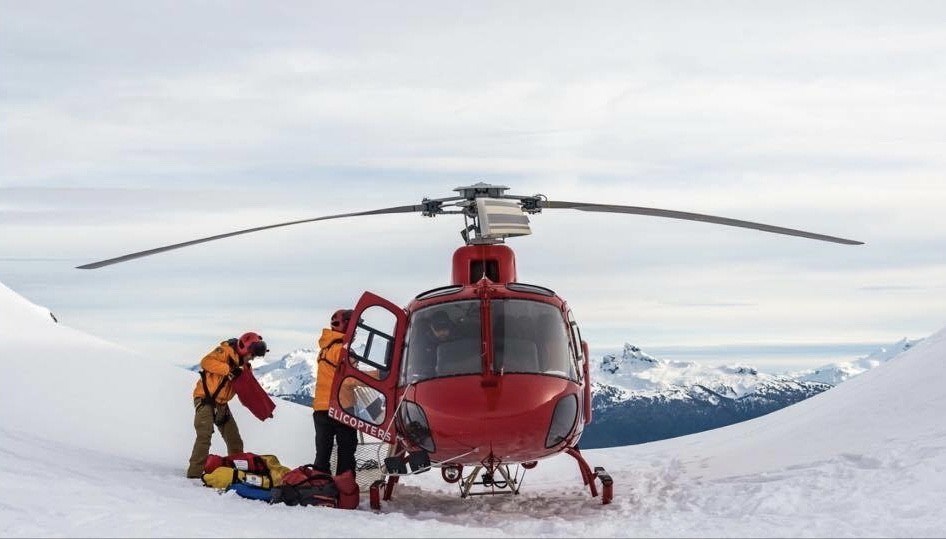Sunny skies and considerable avalanche conditions contributed to a busy weekend for Whistler Search and Rescue (Whistler SAR), with volunteers responding to a total of seven calls in the four-day period spanning from Thursday, March 3 to Sunday, March 6.
Crews attended one incident on both Thursday and Friday, plus two on Saturday and three on Sunday, explained Whistler SAR president Brad Sills. “I don’t know if that’s a record, but it was definitely busy,” he said.
Two of those were avalanche calls that luckily did not result in any injuries to those involved, Sills explained.
The first occurred on Cowboy Ridge on Friday afternoon, when a father and son out for a tour triggered a Size 2.5 slide.
“They were very lucky; they took a big ride and … lost all their equipment,” said Sills. Though the pair were reportedly carrying a tent and were prepared to spend the night in the backcountry if necessary, Whistler SAR volunteers managed to extricate the duo by helicopter just before nightfall. Typically, “an end-of-day call makes it very difficult to attend,” noted Sills.
The second avalanche call came in on Sunday afternoon. A lone skier was caught in a Size 1-to-1.5 avalanche after initiating the slide on the north face of Mount Fitzsimmons—which is “certainly right up there with the most complex alpine terrain in the Spearhead Range, if not the entire Coast Range,” said Sills. “It's definitely serious terrain—by himself, on a 55-degree slope.”
The slide, fortunately, was “almost more like a very large slough". While it carried the skier “some distance,” Sills said the avalanche failed to propagate and did not step down into lower, weaker levels of the slope’s snowpack.
Those incidents came following several slides reported in the Whistler area on Wednesday, including a natural Size 3 avalanche. Most recent avalanche activity in the corridor can be attributed to a persistent weak layer of facets on crust buried under 30 to 60 centimetres of storm snow that fell at the end of February, with Avalanche Canada receiving several recent reports of remotely triggered slides that ran on this weak interface.
On all four days, the Sea to Sky’s avalanche danger was rated as “considerable” for terrain in the alpine and at the treeline, and moderate below the treeline.
In Wednesday, March 9’s public bulletin, Avalanche Canada forecasters said the organization continues to receive reports of persistent slab avalanches releasing on the weak layer. Most slides have occurred on northwest to northeast aspects at treeline and alpine terrain, and have been triggered by riders, naturally and remotely. “Some of the avalanches propagated far, around 200 to 300 [metres],” the bulletin reads.
“Looking forward, it remains possible that persistent slab avalanches could be triggered. Naturally triggered avalanches may be on the decrease during this cool weather period, but human triggering is possible.
Whistler SAR is also aware of four other recreationalist-initiated avalanches that occurred in recent days that did not require assistance, Sills said, adding that he has noticed “a large amount of underreporting” when it comes to avalanches in the area lately.
Failing to report slides can “lead people to believe that there aren't a lot of incidences out there when, in fact, this past week, the contrary was true,” he said.
The other five callouts Whistler SAR responded to in recent days included an injured snowboarder stuck in Wedge Creek—“I’m not sure how they got there, probably out of Phalanx,” said Sills—a pair of serious knee injuries (one at Circle Lake under Blackcomb peak and another on the Iago Glacier), a snowmobiler with a dislocated shoulder on Powder Mountain and a missing hiker at Garibaldi Lake.
“Big packs, spring condition and knees are not a good combination,” said Sills.
In the case of the missing hiker, the search subject returned to the trailhead on their own “right at nightfall,” after crews were previously notified by another hiker that they had seen the man sitting by the lake, “and had cautioned him that he better get going,” explained Sills.
Sills encouraged anyone heading into the backcountry to read not only Avalanche Canada’s public bulletins before heading out, but to look through the Mountain Information Network (MIN) and understand the information relayed in recent reports.
Planning an adventure? To brush up on backcountry skills or for help creating a trip plan, head to adventuresmart.ca.





